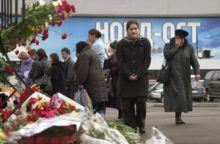On October 23 eight years will have passed since The Day when a group of Chechen terrorists took over 800 spectators and actors hostage at the Theater Center at Dubrovka in Moscow. The attack began while the musical Nord-Ost, based on the famous novel by Veniamin Kaverin Two Captains, was being staged.
The hostages were kept in the building of the Theater Center for three days. In the first minutes of the seizure some of them managed to hide in service rooms, and escape through windows and emergency exits. Five actors escaped from a dressing room. Seven technicians escaped from the editing room. Two girls managed to escape when terrorists brought them to a restroom. They jumped out of a window and broke into a run. Terrorists opened fire from submachine guns but missed them. During the three days terrorists voluntarily released over twenty children and a few dozen adults — mostly women and Muslims. They promised to release fifty more people if President of Chechnya Akhmad Kadyrov would come to negotiate with them. However, the “heroic” president of the puppy regime did not come.
Movsar Barayev directed the group of terrorists. This was the very Barayev about the liquidation of whom the deputy commander of the United Group of Russian Troops in Chechnya Boris Podoprigora had solemnly announced ten days earlier. The requirements of the terrorists were not trivial: to stop the war and withdraw Russian troops from Chechnya.
On October 26 Russian law enforcement forces assaulted the Theater Center using an unknown gas with a soporific affect. As a result of the assault, according to different estimates, 129 to 174 hostages and 40 terrorists died. Almost all terrorists were killed while passed out, most of them — with a shot in the head. Three people were killed directly by terrorists. Two of them, a man and a woman, were not among the hostages; for some unknown reason they “broke” into the building, bypassing the cordons of militia. Terrorists interrogated them, executing them quickly afterwards. One more hostage was killed by accident. A hostage attacked a terrorist with a bottle, following which terrorists opened fire and wounded three other people, one of them later died in hospital. All the other dead hostages are on conscience of the Russian anti-terrorist units.
A lot of things concerning the act of terror at Dubrovka remain obscure. Nobody knows what gas was used during the assault. Nobody ever explained why emergency doctors and receptions of Moscow’s hospitals were not informed about what gas it was so that they would know how to treat it. How did the two persons manage to bypass the cordons and break through into the Theater Center, where they were killed? According to different estimates, this sequence of events lasted between five and twenty minutes. Why were all terrorists, who were already in a helpless state, killed? Why did the emergency services fail to provide qualified help for the victims? Why weren’t the militiamen-looters, who picked up valuables from corpses of the dead hostages in the building, convicted? Why wasn’t there a thorough investigation of the murder of a wounded and helpless person (allegedly, a terrorist) on the stairs of the Theater Center after the assault? The video depicting the scene of killing this man with a shot in the head went viral. Why didn’t Russian anti-terrorist units, the officers and assistants of which infiltrated the Chechen resistance, know anything about the preparation of the act of terror?
There are many questions. And no trustworthy answers. But if one answers these questions using logic and intuition, the following picture emerges. A gas unknown to the civil medicine was used during the assault. The doctors who still could save the victims were not informed about the characteristics of this poisonous substance because it was a state secret. Two people didn’t break through into the Theater Center but were sent there. (I was in front of the Theater Center the night of the assault and can confirm: there were so many lines of cordons that it was impossible to break through them). When the gas was released into the hall, terrorists could activate the explosive device but didn’t do it. It wasn’t their goal. They were not going to kill hostages and didn’t plan to die themselves.
All terrorists were killed to prevent them from giving evidence in court as defendants or witnesses. The emergency services, which can work very well during mass catastrophes (I know it from my own experience of working in them), were not given a possibility to fulfill their duty — starting from an unrestricted access to the site and competent evacuation, to adequate treatment and hospitalization. The wounded terrorist was killed with a shot in the head on the stairs of the Theater Center in accordance with the general scenario — all terrorists must die. The killers didn’t know that a television camera was installed on the roof of the building in front of them, which could catch the events at the entrance of the Theater Center. Russian anti-terrorist units knew about the preparation of the act of terror, but didn’t take any measures to oppose it, due to the underlying political task — discrediting Chechen separatism generally, and the president Maskhadov in particular, in the eyes of the international community.
Certainly, one can discard these meditations as a conspiracy theory. However, there must be a reason why the government has been silent all these eight years, pretending that there are no questions. As a survey recently conducted in Russia by the Yurii Levada Analytical Center showed that 52 percent of respondents believe the authorities told only a part of truth about the terrorist attack. 19 percent believe that all truth is hidden from them. Only 9 percent think the government didn’t hide anything.







